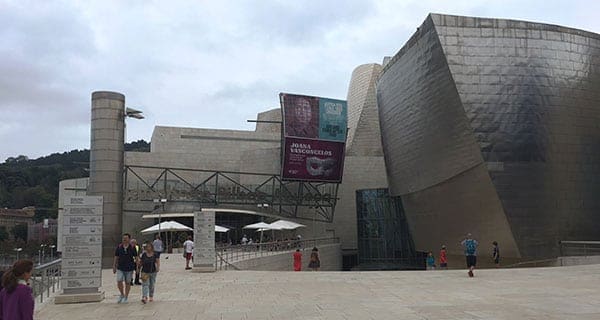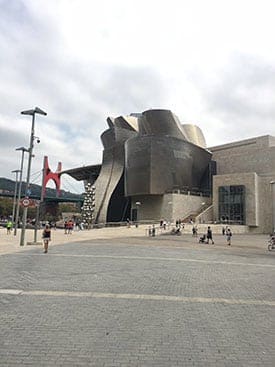 In 1997, the Guggenheim Museum Bilbao opened on the estuary of the Nervion River and immediately became the template for all new cultural institution architecture worldwide.
In 1997, the Guggenheim Museum Bilbao opened on the estuary of the Nervion River and immediately became the template for all new cultural institution architecture worldwide.
Frank Gehry was the building’s visionary architect. His Spanish client was the Basque administration, along with new York’s Guggenheim Foundation. They sought to use architecture and contemporary art to rejuvenate a dying city core.
Their goal was unique at the time; 21 years later, it’s broadly apparent that they have succeeded. Indeed, the economic stimulus role of superb cultural architecture is now an accepted part of contemporary urban design.
I can write this because my observations and readings from a distance have been confirmed with a visit to northern Spain.
Back in 2006 and 2007, as the chief executive officer of Calgary’s Glenbow Museum, I advocated moving the Glenbow from its concrete garage-like home on Stephen Avenue Mall to co-mingle in the new Norman Foster-designed Encana headquarters (The Bow) at 500 Centre Street South.
After two years of diligent fundraising and internal mind wrestling, the new museum project, initially costed at $210 million, proved just too much for Calgary to digest.
The Bow was built, however, for $1.4 billion. And every time I walk by that marvellous structure, I wish we had been able to make the Glenbow’s move a reality.
These feelings of nostalgic architectural ‘might have been’ are running rampant now, after returning from northern Spain and a day’s visit to the Guggenheim Bilbao. The project has transformed an inner-city wasteland into a thriving cultural hub.
The museum is a titanium-and-limestone-clad, ship-shaped structure that defies easy description. Its total form is hard to hold in the mind’s eye, even after a day’s visit. When you first arrive at its eclectic base – which is possible from three directions – the building blatantly entices the viewer to become a visitor.
Perhaps as important, however, are the separately financed and designed buildings that now surround it. Bilbao’s Guggenheim has induced investments in many new commercial buildings (banks, information technology centres, professional offices and malls) designed by the global architectural practices of Arata Isozaki, Norman Foster, Rafael Moneo, Santiago Calatrava, Zaha Hadid and Cesar Pelli.
As a consequence, the area is awash in innovative design and new construction. The Guggenheim Bilbao literally shines (its 33,000 titanium panels change colour in different shades of sunlight) as the backbone of the reborn city centre.
Culturally, the Guggenheim Bilbao also plays its more traditional art museum role, and here the aesthetic critic can find fault in the building’s architecture. Quite simply, it over-shines and dominates the art content. One could argue that the most important piece in the Guggenheim Bilbao’s permanent collection is by Gehry: the building itself.
A video that accompanies the largest installation of permanent collection items (eight sculptures of weathering steel), Richard Serra’s The Matter of Time, suggests some concerns about the form of the gallery. In breaking with the spacial exhibition practices of traditional art galleries, the Guggenheim Bilbao features radial structure and many irregular-shaped galleries that have curved surfaces instead of orthogonal, straight walls.
Many of the museum’s 130 pieces of iconic mid-20th-century-to-present-day art are enormous paintings by Jean-Michel Basquiat, Andy Warhol, Mark Rothko, Robert Rauschenberg and Cy Twombly. Their display requires rectangular rooms with right angles and public space for dead-on contemplation.
The museum’s current guide book explains that the permanent galleries have recently been “reimagined and evaluated based on characteristics and suitability for different types of displays.”
The fact that the interior display spaces are gradually being fine-tuned to comply with the needs of the art, rather than the unique form of the building, is entirely appropriate in the museum world – after all, curators are the content specialists just as architects are the space specialists.
While multiple visits, and ideally living in Bilbao, would enhance one’s ultimate understanding of the Guggenheim Bilbao’s contribution to the Basque region, it’s clear that it works well at many levels.
And as I ponder Calgary grappling with its economic future, I think we missed a great opportunity in 2007 to Bilbao-ize the Glenbow. Perhaps now is the time?
Troy Media columnist Mike Robinson has been CEO of three Canadian NGOs: the Arctic Institute of North America, the Glenbow Museum and the Bill Reid Gallery.
The views, opinions and positions expressed by columnists and contributors are the author’s alone. They do not inherently or expressly reflect the views, opinions and/or positions of our publication.


